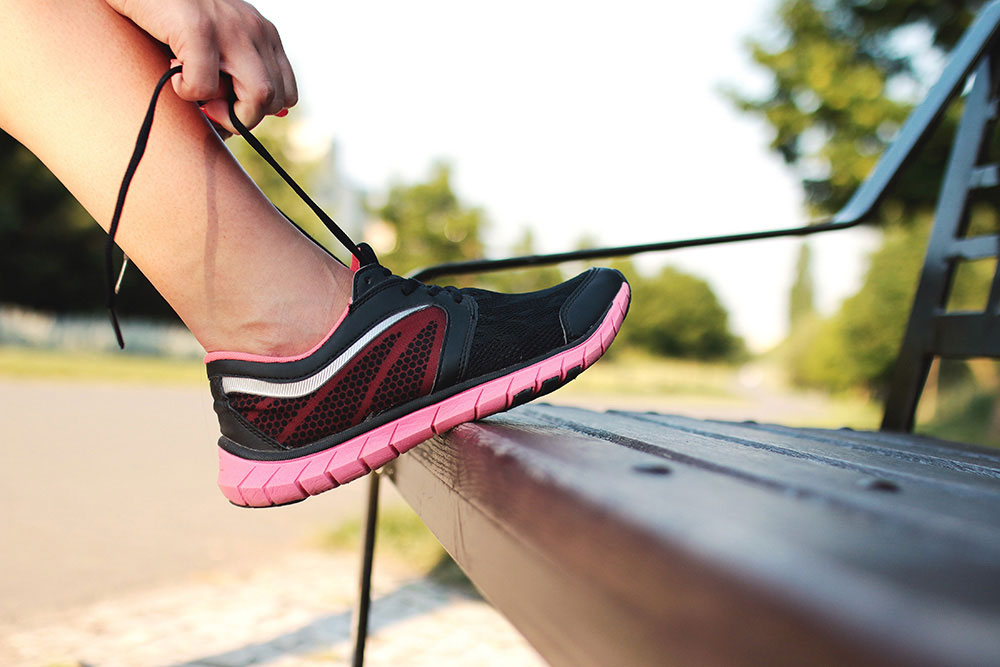
 Attention runners! Whether you’re just starting your first 5K or have completed a few ultra-marathons already, you’re at risk of getting held back by pain and injury. We see hundreds of runners in our clinics across Australia every week.
Attention runners! Whether you’re just starting your first 5K or have completed a few ultra-marathons already, you’re at risk of getting held back by pain and injury. We see hundreds of runners in our clinics across Australia every week.
When we look at why their pain or injury has developed, footwear is often a major contributor, even if the shoes have been purchased from a well-known brand store. Today we’re helping to explain the link between footwear and running injuries and what you can start doing about it today to keep you feeling your best.
The Facts
- We expose our body to the force of up to four times our body weight during running.
- Each person’s natural variances in foot shape, movement and bone alignment means that their feet will be impacted by this force differently. Some will absorb it well, and others may develop painful injuries like stress fractures.
- Your shoes become the ground you land on with every stride. They help your feet function well and absorb the impact, and may even contribute to the development of pain and injuries, especially when your shoes are unstable or ill-fitting.
With this in mind, many of us still leave the critical decision of footwear up to what’s on sale that weekend, often resulting in shoes that aren’t matched to our foot type. To understand your foot type better, learn more about flat feet and high arched feet.
If you want to help prevent injury and improve your performance during running, start with these approaches:
Find The Perfect Fit, Not Brand
It’s not all about the brand! While we love certain brands for running, such as Saucony and New Balance, you must ensure that you have the right fit before you consider style or features. Incorrectly fitting shoes can cause a multitude of problems for your feet: everything from numbness and burning to blisters and painful calluses.
- Shoes that are too short can result in black toenails (as the toe bleeds beneath the nail).
- Shoes that are too narrow in the forefoot can cause pinched-nerve pain, bunions, corns or calluses.
- Shoes that are too wide allow the foot to slide around, which causes undue friction, which in turn can lead to blisters.
We have many people come to us that typically have difficulty finding the right shoe fit. Their feet may be particularly long, short, narrow or wide. Our team are trained in shoe fitting and know the tips and tricks to find the perfect fit with the most comfort and optimal performance. Best of all, footwear measurement and fittings are free.
If you would like to see how your shoes are impacting the force and pressure on your feet during your gait, our podiatrists will assess this during your video gait analysis. Book an appointment online now.
Take Care Of Your Perfect Runners
The average life of most running shoes is 500-800 km, but if you’re a heavier or taller runner, or if your gait isn’t smooth, you may increase the typical wear and tear on your shoes.
Shoes wear out because of all the repetitive forces placed on the materials that cause them to compress or wear down as they impact the ground. Your shoes’ ability to support, stabilise and control your body can worsen over time. Here are two things you can do to help:
- Buy two pairs of shoes at the same time and alternate between them when you run. This will give the materials more time to ‘recover’ and extend the lifespan of both pairs by up to two times. If you have one pair and love them, purchase that second pair before your first pair wears down.
- Come in for a shoe fitness check. Our footwear sales staff will be able to tell you whether your shoes have life left in them or if it’s time for a new pair.
Looking to purchase a new pair of shoes? Shop online at our My FootDr Shop for great deals.
Don’t Forget Your Orthotics
Your foot orthotics have a specific function with a precise level of control. The shoes you select will also have features that can either amplify or reduce the function of your orthotics. It’s important to get this balance right and have the two work together to get the best outcome. Our team can help you get this balance right.
We’ll also consider the depth at the heel of your running shoe as well as how your foot will sit in the shoe with your orthotics. If the depth and room in your footwear is insufficient, your foot may end up sitting high in the shoe with the heel lifting up every time you walk and run. At the far end, your toes and midfoot may feel tight and cramped.
Don’t worry! Our team know exactly what footwear is suitable for orthotics. We’ll help you find the most comfortable footwear based on the activity that you need them for, whether that’s running, a casual stroll or enjoying a night out with dress shoes.
Shop online to see our wide range of footwear before your shoe fitting.
Happy Running & We’ll See You Soon!
If your running has stalled due to pain or injury, you can book in with one of our experienced Podiatrists here. We will assess the biomechanics of your feet while you run and work with you to help prevent injury and improve your performance. Our custom foot orthotics can improve support and performance by conforming directly to the unique shape of your feet. They’re made using the latest 3D scanning and printing technology for the highest accuracy. Happy running!


